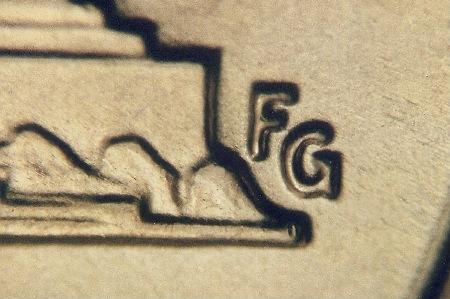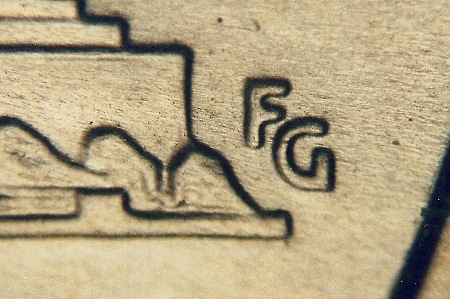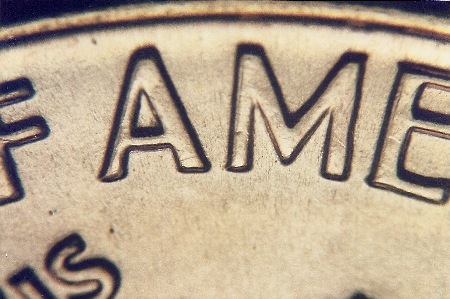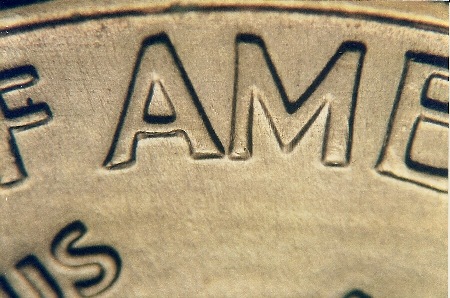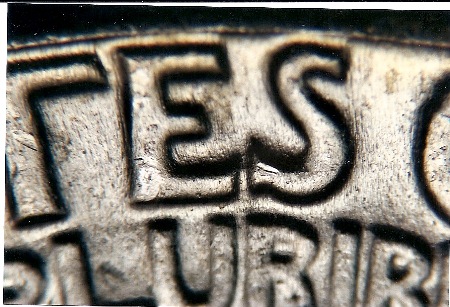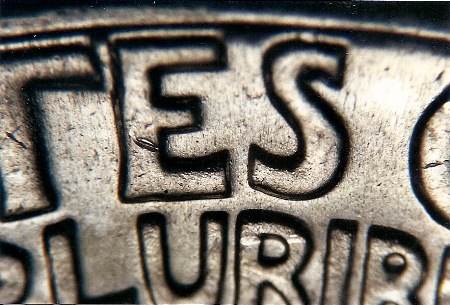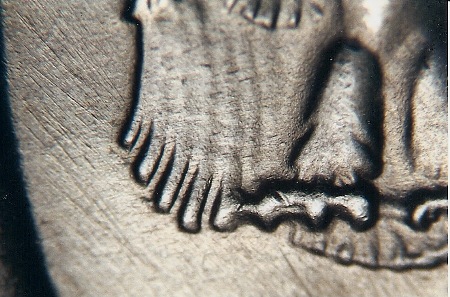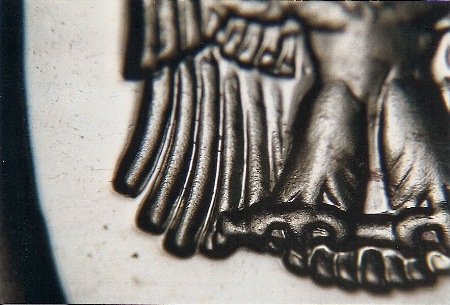


 |
 |
 |
 |
 |
 |
 |
 |
 |
 |
 |
 |
 |
 |
 |
 |
 |
 |
 |
 |
 |
 |
 |
 |
Unlike the Transitional Design Varieties in which a coin design is used in a year when it shouldn't be used, the Wrong Design Varieties have a coin design being used in the correct year, but on the wrong type of coin. The instances that we are aware of have occurred in years when there were differences between the design for proof strike coins and the design for circulation strike coins for a given denomination. While knowledge of these variety types has been with us for some time, the hobby was reawakened to them when I had a front page article in the January 22, 2001 issue of Coin World announcing the discovery by Maximillian Lucas of a year 2000 circulation strike Lincoln cent with the proof strike design. Prior to the appearance of this article it appears that very few in the hobby were aware that from 1994 through 2008 the Lincoln cents appeared with two different reverse designs. The circulation strike coins had one design while the proof strike coins featured a different version of the design. Throughout the 50 year history of the Lincoln Memorial cent the Mint modified the Memorial reverse design six times creating 7 different versions (the original plus the six modifications). Probably the easiest way to spot the various reverse modifications is on the designer's initials FG. The last modification came in 1993. From 1989 through 1992 the Mint used the Lincoln Memorial reverse design that we identify in the Wexler Files as Lincoln Memorial Reverse Design #6 (LMRD-006). LMRD-006 has a distinct serif at the top left side of the vertical bar of the G in FG. In addition to that, the vertical bar of the G in FG extends down below the lower right curve of the G. Like all of the previous designs, there is a significant spacing between the bottoms of the A and M in AMERICA. For the new design introduced in 1993 (LMRD-007), the serif at the top of the vertical bar on the G of FG was no longer there. Also, the vertical bar of the G did not extend below the lower right curve of the G.
Here we see the designer’s initials on the Lincoln Memorial reverse design that we have identified as LMRD-006 (1989 through 1992). There is a distinct serif on the top left side of the vertical bar of the G. Also, the vertical bar of the G extends below the lower right curve of the G.
This is the modified reverse design for the Lincoln Memorial cents that was introduced in 1993 (LMRD-007). It no longer has the serif on the top left side of the vertical bar of the G and the vertical bar of the G does not extend below the lower right curve of the G as it did on LMRD-006. There was another very significant difference between the design used from 1989 through 1992 (LMRD-006) and the new design introduced in 1993 (LMRD-007). On the new 1993 reverse design the bottoms of the A and M in AMERICA are almost touching. All previous reverse designs had a significant space between the bottoms of the A and M.
This is the AM in AMERICA on the reverse design identified as LMRD-006 (1989 through 1992). Note the separation between the bottoms of the A and M in AMERICA. It has frequently been referred to as the “Wide AM” reverse even though all previous Lincoln Memorial reverse designs had similar separations between the A and M in AMERICA.
This is the AM in AMERICA on the reverse design identified as LMRD-007 which was introduced in 1993. There is virtually no separation between the bottoms of the A and M in AMERICA. It has frequently been referred to as the “Close AM” reverse. Like all of the previous Lincoln Memorial reverse designs, LMRD-007 was used in 1993 for both the circulation strike cents and for the proof strike cents. However, in 1994 the Mint decided that it would no longer use LMRD-007 for the proof cents and reserved that design for the circulation strike cents struck from 1994 through 2008. For the proof cents, the Mint went back to the LMRD-006 design. LMRD-006 was then used for the proof cents struck from 1994 through 2008. This set the stage for the discovery by Maximillian Lucas of a 2000 circulation strike Lincoln cent with the LMRD-006 proof design. Because the easiest way to spot the proof design on the circulation strike coins was the separation between the bottoms of the A and M in AMERICA, it quickly became known as the 2000 "Wide AM" Lincoln cent variety. The normal 2000 circulation strike coins were referred to as the "Close AM" variety. The find quickly sent collectors hunting through their Lincoln Memorial cents for this variety, and possibly for similar varieties on other dates. It didn't take long for examples to turn up on 1998 dated Lincoln Memorial cents and also on 1999 dated Lincoln Memorial cents. In the Wexler Die Variety Files we have maintained a file on the different working dies affected for those years. Our purpose in doing so was simply to get an idea of how scarce the varieties were for each of the three years (1998, 1999, and 2000). To date we have 31 different circulation strike working dies identified for the 1998 "Wide AM" cents, 4 different circulation strike working dies identified for the 1999 "Wide AM" cents, and 23 different circulation strike working dies identified for the 2000 "Wide AM" cents. Clearly the 1999 "Wide AM" cents are the most difficult to find and command the greatest premiums. To make things even more interesting, over a period of time collectors eventually found 1998-S and 1999-S proof cents with the circulation strike "Close AM" design. Only 1 working die for each has been identified making them extremely rare since the average life of a Lincoln cent proof die is about 3,000 coins. The practice by the Mint of using different designs between the circulation strike coins and the proof strike coins is not new. From 1932 through 1964 the Mint used different designs for the reverse of the Washington quarters. The circulation strike design is popularly referred to as the "Type A Reverse." In the Wexler Die Variety Files we refer to it as Washington Quarter Reverse Design #1 (WQRD-001). This reverse is somewhat low in relief and is usually identified by close spacing between the bottoms of the E and S in STATES. The proof design is often referred to as the "Type B Reverse", or WQRD-002 in my files, and is characterized by a much higher relief, and has a much wider spacing between the bottoms of the E and S in STATES. For all of the years from 1956 through 1964 circulation strike Washington quarters can be found with the normal circulation style "Type A" reverse, and also with the proof style "Type B" reverse. Since these can be found during all of these years, it is highly unlikely that proof reverse dies were mistakenly used to make circulation strike coins. It was most likely an effort by the Mint to save some money and time by not wasting the proof reverse dies. After a few thousand proof strikes they may have no longer been acceptable to strike proof coins, but could be used to strike many thousands of coins for circulation.
Here we see the "Type A" reverse for the Washington quarters. It was used for circulation strike quarters struck through 1964. Note that there is little space between the bottoms of the E and S in STATES.
Here we see the so-called "Type B" reverse for the Washington quarters. It was used for the proof quarters through 1964. From 1956 through 1964 it can also be found on a small percentage of circulation strike quarters. The Mint also used different styles of reverse for the circulation strike and the proof strike Franklin Half dollars. The easiest place to spot the difference is on the eagle. The circulation style reverse (Type 1 Reverse) has an eagle with 4 distinct feathers on the right wing (viewer's left). The proof style reverse (Type 2 Reverse) has an eagle with 3 distinct feathers on the right wing (viewer's left).
This is the Type 1 Reverse for the Franklin Half dollars. It is the normal reverse for the circulation strike half dollars. Note the 4 distinct feathers on the eagle's right wing.
This is the Type 2 Reverse for the Franklin Half dollars. It is the normal reverse for the proof strike half dollars. Note there are only 3 distinct feathers on the eagle's right wing. The circulation strike Franklin Half dollars dated 1958 and 1959 can be found with both the Type 1 and the Type 2 reverse. The Type 2 is much scarcer than the Type 1, but that is not a surprise since they most likely originate from reused proof dies just like the Type B circulation strike Washington quarters for the same time period. A collection containing both varieties wherever they exist can be a fascinating collection. If you are aware of other examples of wrong design varieties, we would love to hear from you. | ||


